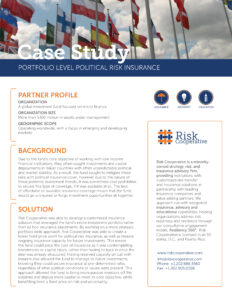Insurance Solutions
Property and Casualty
Risk Cooperative works with clients to provide insurance across all their property and casualty needs. Our team of risk specialists can aid with the origination, quoting and placement of property and casualty insurance solutions around the world.
With a detailed understanding of our client’s operations, risk exposure and strategic objectives, our team leverages its extensive expertise to negotiate the best possible terms for clients. No matter the class of insurance, Risk Cooperative works to ensure that any pro-active risk management and other such initiatives are taken into consideration during the underwriting process.
Programs Include:
Property
Our team can help organizations protect their physical assets, equipment and other property assets to ensure operational continuity. A range of insurance solutions are available across all business needs, including but not limited to:
- Commercial Property
- Inventory and goods in transit
- Business income interruption coverage
- Inland transit
- Electronic data processing (EDP) coverage
- Builders Risk Insurance
- Commercial Fleet insurance
- Marine Cargo Insurance
Liability
Liability insurance is a critical component of any organization’s insurance portfolio. We work closely with organizations to ensure that they have the right insurance programs in place for preventing potential exposures. A wide range of liability insurance solutions are available and can be customized to meet unique client needs. Our available liability solutions include, but are not limited to:
- General and Product Liability
- Professional Liability/indemnity
- Errors and Omissions insurance
- Environmental impairment
- Medical malpractice
- Product recall
- Umbrella liability and excess
- Management Liability
Workers Compensation
Risk Cooperative provides workers compensation programs to ensure clients can provide employees with the adequate, compliant level of coverage in the event of work-related accidents, illnesses and death. Requirements vary by state, and our team will ensure clients meet the necessary compliance requirements.
- Workers compensation
- Defense Base Act (DBA)
Custom Tailored Programs
Risk Cooperative can create custom tailored solutions and product bundles as a part of our brokerage process, designed to meet client specific needs or requirements.
Property
Our team can help organizations protect their physical assets, equipment and other property assets to ensure operational continuity. A range of insurance solutions are available across all business needs, including but not limited to:
- Commercial Property
- Inventory and goods in transit
- Business income interruption coverage
- Inland transit
- Electronic data processing (EDP) coverage
- Builders Risk Insurance
- Commercial Fleet insurance
- Marine Cargo Insurance
Liability
Liability insurance is a critical component of any organization’s insurance portfolio. We work closely with organizations to ensure that they have the right insurance programs in place for preventing potential exposures. A wide range of liability insurance solutions are available and can be customized to meet unique client needs. Our available liability solutions include, but are not limited to:
- General and Product Liability
- Professional Liability/indemnity
- Errors and Omissions insurance
- Environmental impairment
- Medical malpractice
- Product recall
- Umbrella liability and excess
- Management Liability
Workers Compensation
Risk Cooperative provides workers compensation programs to ensure clients can provide employees with the adequate, compliant level of coverage in the event of work-related accidents, illnesses and death. Requirements vary by state, and our team will ensure clients meet the necessary compliance requirements.
- Workers compensation
- Defense base act (BDA)
Custom Tailored Programs
Risk Cooperative can create custom tailored solutions and product bundles as a part of our brokerage process, designed to meet client specific needs or requirements.
Resource Library
The hazardous working environments within its warehouses could begin to hurt the company’s bottom line as well.
Amazon’s Fulfillment Centers are Deemed Unfulfilling
According to the Seattle Times, Washington state’s labor agency reported that workers in Amazon’s highly automated warehouses are injured at a higher rate than people working in other types of storage facilities. In December, the labor agency announced a new fulfillment center classification for warehouse employees to calculate workers’ compensation insurance rates.
Previously, the State Department of Labor & Industries has grouped Amazon fulfillment centers with other types of warehouses when calculating premium rates. The increasing injury rates within the fulfillment centers raised cause for concern, leading several grocery distributors and recycling facilities within Amazon’s industry-specific risk class to complain that Amazon’s poor performance attributed to the significant increase in premiums for the entire industry.
In addition to the new fulfillment center classification, Amazon’s workers’ compensation costs in the state have increased by 15% as of January 1st, while most other warehouse operators have seen costs decrease by 20%.
Higher insurance rates in Washington are hardly a threat to Amazon, which has benefited from a surge in online orders during the COVID-19 pandemic and watched its share price rise more than 70% in 2020. However, the company’s home state of Washington is a “pioneer of worker rights and could prompt other jurisdictions to follow suit,” according to labor economists’ comments in the Associated Press. Amazon has operations in major states including California, Kentucky, Oregon, Ohio, and Pennsylvania. If other state labor agencies make changes similar to Washington, Amazon could be on the hook for millions of dollars in extra workers’ compensation costs.
State of the Union: An Emphasis on Workplace Health and Safety
Although Washington state’s re-classification and adjusted rates for Amazon’s fulfillment centers are steps in the right direction, the main concern surrounding Amazon’s hazardous working conditions is still at large. In October, the Los Angeles Times reported that two Amazon warehouses in California were cited by the Occupational Safety and Health Administration (OSHA) for health and safety violations related to COVID-19. The state’s OSHA division issued fines for failing to mitigate potential exposure to the virus by providing adequate health and safety training. The fines, which were reported to be in total of $1,870, are unlikely substantial enough to alter the company’s workplace and safety regulations. If increased insurance premiums and regulatory fines will not encourage Amazon to significantly improve workplace conditions in warehouses, what will?
According to NPR News, Amazon workers at an Alabama warehouse are moving closer to holding a vote on whether to form the first U.S. union in the company’s history. If a union contract is granted, members can form a worker safety committee and negotiate the highest safety standards and protocols for the workplace.
The scrutiny over Amazon’s disregard for its workforce and safety regulations throughout the pandemic is a stark contrast to the efforts put forth by Tyson Foods, Inc. and PepsiCo, Inc. last year, with both organizations protecting their workforce through employee bonuses, enhanced benefits, and increased operational safety measures. While it remains to be seen how Amazon will respond to the increased workers’ compensation costs and possible union formation, the end game should focus on the overall health and safety of its employees. A highly engaged workforce morale delivers increased employee retention, recruitment, and productivity; leading to a bottom line that is valuable to all parties involved.
This material has also been developed into a downloadable resource to read and share. Insurance Insights | Business Coverage
As an organization navigates its growth cycle, from start up to multinational corporation, insurance needs will vary. Early stage companies often are driven by compliance when purchasing coverage, yet leveraging insurance and risk transfer solutions more strategically can help younger organizations become more resilient, transfer financial risk, and withstand many of the uncertainties companies of all sizes will face throughout their operating years.
As organizations evaluate their insurance needs, they can compartmentalize key coverages for consideration into phases that match their current size and operational requirements.
The procurement of basic insurance coverages for businesses can be broken down into four phases.
Phase I: Basic Operating Coverages
Organizations that are commencing operations with a few employees should consider these following coverages:
Business Owners Policy (BOP)
A business owner’s policy, or BOP, combines the most common types of property and general liability insurance into one convenient, comprehensive package at a competitive rate. BOP insurance is generally purchased by small businesses. Mid-market and larger businesses with more complex insurance needs generally buy separate policies for each type of insurance. A BOP protects a company from a wide variety of damage, from customer falls to property damage. Since the insurance is bundled, a business owner’s policy is often less expensive than if individual coverage was purchased separately, however it also offers lower limits of protection. Hired and Non-Owned Auto (HNOA) coverage protects against lawsuits from accidents involving personal, rented, or leased vehicles used for work purposes. HNOA can be added onto a BOP if needed.
Workers Compensation
Most states require companies to provide workers compensation insurance when there are more than a certain number of employees, varying from three to five, depending on the state. Workers comp insurance pays for medical care and replaces a portion of lost wages for an employee who is injured in the course of employment, regardless of who was at fault for the injury. Should the death of an employee occur while they are working, the insurance provides compensation to the employee’s family.
Errors & Omissions (also called Professional Liability or E&O)
Companies that provide professional services such as giving advice, making recommendations, designing things, providing physical care, or representing the needs of others should purchase errors and omissions insurance. This type of coverage protects an organization against third party lawsuits by customers, clients, or patients claiming that the business’s failure to perform a job properly has injured them. The policy will pay any judgment for which the company is legally liable, up to the policy limit. It also provides legal defense costs, even when there has been no wrongdoing. For companies in the technology industry, there is a special coverage called Tech E&O. Click here for a detailed explanation of Tech E&O.
Cyber Insurance
In today’s highly digitized world every company, regardless of size, is exposed to cyber risks. From ransomware attacks compromising systems, to compliance-related expenses for personal data exposure, a cyber breach can be very costly and often put younger, cash strapped organizations at the brink of bankruptcy. A stand-alone cyber insurance policy provides protection to a company if a cyber or data breach occurs. This type of policies provides several different components of coverage including:
- Liability protection against third party lawsuits in the event employee or customer data is compromised.
- Breach response coverage for the costs to bring in experts that can identify any intruders to a company’s systems.
- Breach response coverage to mitigate the breach so systems can be fully restored to normal operating standards.
- Ransomware protection in the event that a company’s systems are hacked or held hostage by a cybercriminal.
- Notification and credit monitoring services in the event of a breach to notify any affected individuals.
- Business interruption costs incurred as a result of a potential cyber-attack.
All businesses that use computer systems, the internet, or hold data are vulnerable to cyberattacks and should have a cyber insurance policy in place. This type of policy can provide the funds to react quickly to restore customer confidence and mitigate further damage. Some insurance companies include consulting services to help you put software and systems in place to avoid such attacks in the first place. However, organizations must also be aware of common exclusions.
Employee Benefits
Employee benefits are additional methods of compensation offered to employees that are separate from their salaries and wages. Traditional health insurance plans (such as medical, dental, and vision) are the common foundation of an employee benefits package. Employer sponsored medical plans are designed to be more cost-effective for businesses and employees because the risk is spread across a larger number of people, and the ease of enrolling in an employer’s health plan exceeds the burden of shopping for coverage on their own. Employees are drawn to businesses that offer a robust employee benefits package, and combining ancillary benefits (such as life, short-term disability, and long-term disability) with traditional health insurance plans is a significant catalyst for recruiting and retaining a talented workforce. Offering employee benefits also creates tax advantages for businesses. Employers can typically deduct 100% of the premiums paid toward health insurance and, depending on the size of the business, may be eligible for small business tax credits.
Phase II: Strategic Liability and Risk Transfer
As an organization starts expanding its employee count beyond 10 employees, or starts generating sizeable revenues, it is important to start considering the organization’s broader liability exposure. The following coverages should be considered:
Directors & Officers (D&O)
Directors and officer’s liability insurance protects directors and officers of a firm if there is a lawsuit claiming they managed the business without proper regard for the rights of others. The policy will pay any judgment for which the firm is legally liable, up to the policy limit. It also provides for legal defense costs, even where there has been no wrongdoing.
Employment Practices Liability Insurance
Employment practices liability insurance covers (up to the policy limits) damages for which an employer is legally liable such as violating an employee’s civil or other legal rights. In addition to paying a judgment for which the employer is liable, it also provides legal defense costs, which can be substantial even when there has been no wrongdoing.
Fiduciary Liability Insurance
Provides coverage for damages caused by a breach of fiduciary duty by an employer. For example, by offering a retirement plan to employees, such as a 401(k), an employer is acting in the capacity of a fiduciary and is subject to claims for damages due to scenarios such as mismanagement of investment funds or poor performance of the retirement plan. This coverage can also be applied to damages due to the advising of employees for an employer’s benefits plan (an employer advises an employee to select a benefits plan that results in insufficient coverage).
Keyperson Insurance
A business that relies on key employees or executives should have “Key Person” policies for employees without whom the business could not function. Key Person Insurance protects against a key employee’s unexpected death – often the benefit amount equals the expected revenue loss and costs required to find and train a suitable replacement. The business pays the premiums, and the insurance is considered a business asset.
Phase III: Building Resiliency
As your growth continues to scale past 25 employees, it is important to build resiliency and ensure busines continuity. Organizations should consider the following coverage:
Employee Benefit Liability (EBL)
This covers the liability of an employer for an error or omission in the administration of an employee benefit program.. As employee headcount grows, the chance for errors in processing employee benefits grows, for example if an employer accidentally forgets to enroll an employee in the benefit program, and that employee must pay out of pocket for a doctor visit. In many cases, EBL Coverage can be included in a BOP. Fiduciary Liability coverage provides an employer coverage for the advising of employee benefit plans, while EBL provides coverage for the administration of employee benefits plans.
Phase IV: Specialized Risk Mitigation
As the organization continues to grow, expanding both its staff and operational geography, specialized coverages may be required. Depending on the nature of an organization’s business, unique insurance solutions should be contemplated to limit potential risks. Such specialized coverages include, but are not limited to:
Kidnap/Ransom/Extortion coverage – provides protection for employees traveling to high risk regions
Defense Base Act (DBA) coverage – specialized coverage for organizations bidding on government contracts to expand workers compensation coverage for staff performing contract work at U.S. military installations around the globe.
Business Travel Accident (BTA) provides emergency medical and evacuation coverage for organizations with employees traveling internationally.
International Property and Liability Coverage – When an organization starts working internationally, it is important to make certain the coverage in place is adequately covering international risks. Not all policies are created equal and, in some instances, it is required to take out specialized liability and property policies to cover operations overseas.
Timing of these four phases can vary based on a variety of factors such as an organization’s industry, growth trajectory, or requirements mandated by any contracts awarded to a company. Similarly, the limits of liability for each of these coverages will vary based on these factors. It is important that companies consult their insurance broker on a frequent basis during the year as limits of liability may change based on company growth or contraction.
YOU MIGHT ALSO BE INTERESTED IN:
In this episode of Risk Matters, we are going to do a “deeper dive” on some of the thought leadership and concepts we’ve developed at Risk Cooperative. Today, we discuss the need to have your insurance coverage reviewed periodically to avoid costly coverage gaps. YOU MIGHT ALSO BE INTERESTED IN: Insurance Solutions Risk Benchmarking
In this episode of Risk Matters, we are going to do a “deeper dive” on some of the thought leadership and concepts we’ve developed at Risk Cooperative.
Today, we discuss the need to have your insurance coverage reviewed periodically to avoid costly coverage gaps.





